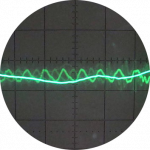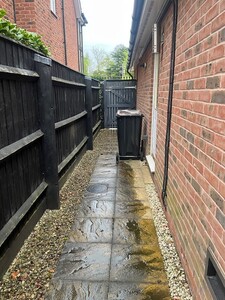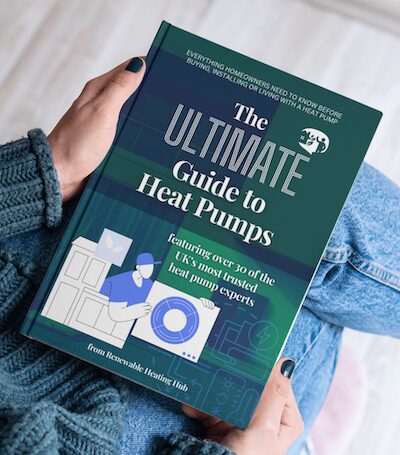Air Source Heat Pump - Side Alley Suitability
Hello,
Has anyone been able to install a heat pump in a relatively narrow side alley? We have a side alley which would be the ideal location for a heat pump as it runs alongside the garage where the existing gas boiler is located. The alley is relatively narrow (1.45m wide) but there’s excellent air circulation as wind blows down it freely. This really is the only feasible location so I’m trying to understand if it’s a non-starter from an air circulation perspective. Photo attached showing the side alley and my thinking is that the heat pump (initial research shows it would be a 10-12kW unit) would be positioned where the bin is.
Cheers
Welcome to the forums, and this is an excellent question.
It definitely doesn’t sound like a non-starter, especially with 1.45m of width and good natural airflow. A lot of units have been successfully installed in tighter spots than that, but it really depends on how the air moves in and out once the unit’s running. What sounds like great ventilation in calm weather can become a recirculation nightmare when the unit is pulling in and exhausting air at full pelt.
One thing I’d suggest before committing is doing a smoke test. It’s a simple and cheap way to visualise airflow and see if exhaust air is going to get drawn straight back into the intake, which would affect your efficiency. See the video below on what a smoke test reveals. This is a video from one of our members, @heat-pump-newbie
Positioning the unit where the bin is looks sensible in theory, but orientation will matter. Ideally, you want to avoid blowing exhaust air into a corner or wall that could cause it to bounce back. If the prevailing wind moves cleanly along the alley, and you can orient the unit to work with that, you’re probably in good shape.
Get a copy of The Ultimate Guide to Heat Pumps
Subscribe and follow our YouTube channel!
@ad3628 I’ve seen loads of heat pumps successfully installed in alleys like yours. A good installer should get the orientation and positioning right. Let me know if you’d like any installer recommendations.
Get a copy of The Ultimate Guide to Heat Pumps
Subscribe and follow our YouTube channel!
Posted by: @ad3628Hello,
Has anyone been able to install a heat pump in a relatively narrow side alley? We have a side alley which would be the ideal location for a heat pump as it runs alongside the garage where the existing gas boiler is located. The alley is relatively narrow (1.45m wide) but there’s excellent air circulation as wind blows down it freely. This really is the only feasible location so I’m trying to understand if it’s a non-starter from an air circulation perspective. Photo attached showing the side alley and my thinking is that the heat pump (initial research shows it would be a 10-12kW unit) would be positioned where the bin is.
Cheers
My installer wasn't at all keen on this option, and we had alternative location. That said Heat geek once did an experiment where they virtually surrounded a heat pump with barriers, and it made very little difference to performance!
If you can lift the heat pump say a meter off the ground it should help, because the cold exhaust air can then fall away and create a convection circulation (warm air in from above and sides, cold air out low down) which should reduce any chance of blowback. If the top were say just level or just below with the top of the fence that might be a good way.
12kW is quite large both physically and in terms of capacity and there is a bit of a tendence in the industry to overestimate. Do you have your historic gas consumption and/or what is the house floor area and construction. It looks relatively modern from the photo.
4kW peak of solar PV since 2011; EV and a 1930s house which has been partially renovated to improve its efficiency. 7kW Vaillant heat pump.
@jamespa It was that HeatGeek video on air recirculation that gave me hope on the side alley!
The house was built in 2003 with cavity wall insulation and double glazing throughout. The loft is also partially boarded with 100mm insulation in the unboarded areas so that could easily be improved. It's around 250m2 with 21 radiators although i know the kitchen area will need another one added as it's the coldest room in the house. Most of the radiators get warm but not hot to the touch despite the boiler hitting 70-80 degrees. An example of the inefficiency was we used 3456kWh of gas between 05DEC24 - 04JAN25 (at a cost of £204) and the downstairs wasn't exactly toasty!
A plumber suggested a low loss header and additional pump would get the radiators up to temperature as there a number of long pipe runs which the existing pump is struggling with. The radiators are fed by plastic 10mm microbore piping which come off 22mm copper. The online HeatGeek tool has projected the heat loss at 8.5kw but a proper survey will give me accurate information.
Given the cost of a power flush, low loss header and pump installation and hefty winter gas bills, i'm hoping a heat pump is a viable option especially as we have solar and battery storage.
@editor Thanks - i've managed to perform a smoke test. The conditions have been ideal for testing as it's one of the few days where there is next to no breeze/wind. Hopefully they upload and are potentially useful to others
Posted by: @ad3628@jamespa It was that HeatGeek video on air recirculation that gave me hope on the side alley!
The house was built in 2003 with cavity wall insulation and double glazing throughout. The loft is also partially boarded with 100mm insulation in the unboarded areas so that could easily be improved. It's around 250m2 with 21 radiators although i know the kitchen area will need another one added as it's the coldest room in the house. Most of the radiators get warm but not hot to the touch despite the boiler hitting 70-80 degrees. An example of the inefficiency was we used 3456kWh of gas between 05DEC24 - 04JAN25 (at a cost of £204) and the downstairs wasn't exactly toasty!
A plumber suggested a low loss header and additional pump would get the radiators up to temperature as there a number of long pipe runs which the existing pump is struggling with. The radiators are fed by plastic 10mm microbore piping which come off 22mm copper. The online HeatGeek tool has projected the heat loss at 8.5kw but a proper survey will give me accurate information.
Given the cost of a power flush, low loss header and pump installation and hefty winter gas bills, i'm hoping a heat pump is a viable option especially as we have solar and battery storage.
There are enough red flags in this to be concerning. I am going to keep this short, there is quite a lot to say/ask about what you have told us but I will stick to the essentials.
From what you have said the main issue you currently have is the distribution system. A heat pump will not, in itself, fix this - indeed if anything it will make it worse because heat pumps run at a reduced DT from flow to return, which means you need to push more water through the system.
That doesn't mean that installing a heat pump with any necessary upgrades to the distribution system isn't viable, it definitely is, but you definitely need a proper designer not a 'grant harvester' to take this route. Also note that heat pumps will not make your radiators hot, they work by having (generally larger) radiators luke warm. Of course a properly designed heat pump system will make your house warm, as warm as you choose to make it.
Im also concerned about your heat loss, there is a big difference between say 8kW and say 12kW and knowing which it is could make quite a difference, particularly to the design of the distribution system, for example it could make the difference between having to upgrade the pipework or just pushing it to its limits. Your 3456kWh of gas went somewhere, and unless it went up the flue it heated the house. FWIW my house, (200sqm 1930s build with partial fabric upgrades - 7kW loss at -2) needed 3600kWh delivered in January (electric consumption 986kWh). This is very similar to yours, suggesting that the Heat Geek 8.5kW (or less) is much closer than 10-12kW which is anyway high for a relatively modern house.
If I were in your situation I would go slowly and methodically and find an installer who really understands what he is doing. I would also try to collect some gas readings (if you have a smart meter download them from your supplier) so I had a handle on actual loss. Critical are a sound determination of heat loss (surveys can be a long way out so it would help to have some independent measure, eg your gas readings - do you have a smart meter) and design of the distribution system/radiator selection. I would also post back here as I go along to sense check what you are being told.
I hope that helps/.
4kW peak of solar PV since 2011; EV and a 1930s house which has been partially renovated to improve its efficiency. 7kW Vaillant heat pump.
@jamespa Thanks very, helpful and i appreciate you taking the time to respond. As you rightly mention, i'm taking this all very slowly as i want to get this right first time and this forum has been very helpful in starting to build an understanding. A neighbour had a similar heat distribution issue and the hydraulic separation/low loss header and pump resolved the radiator issues but in some ways, that's a moot point given that radiators fed by a heat pump will run at lower temperatures.
The 10-12kW figures were bandied around by a local installer who spent all of 5 minutes walking around and was grumbling about the microbore piping - as you can imagine, i've discounted him straight away given the lack of meaningful interest and empirical approach as the online HeatGeek tool was more insightful. I have my gas usage figures for the last year and Aira are visiting next week although i appreciate that will be less a detailed system design/heat loss assessment and more a sales pitch given the early stage. But i have to start somewhere!
All sounds sensible to me and to be clear, the idea of swapping to a ASHP at the same time as fixing the distribution is sound IMHO, if you are going to make major changes you might as well make them all in one go!
If you have gas usage for last year with any granularity then I suggest doing a plot vs outdoor temperature or degree-days. Assuming your house was reasonably warm most of the time, then this will give you an upper limit on your loss. My plot is below, this is daily data delayed by 12 hours (which gave best fit) over 2 years, but a year is sufficient. This plot proved beyond any reasonable doubt that my house loss is ~7kW not the 16kW that two, three hour long, surveys claimed (long story, and possibly an extreme example, which nevertheless shows that surveys cant always be trusted - GIGO!). Obviously the best measured results are going to be if you were deliberately to operate your boiler like an ASHP, ie flow temperature turned down and on 24*7 at least during the season peak. I did actually do this, but you will get useful data even if you didn't.
It would also be helpful to try to work out where the energy might be going. If your rads are cold at both ends but the pipe leaving the boiler is hot, then the energy is getting lost in the pipework (which presumably means that it is still heating your house - basically you have UFH!). Quite likely there is a bypass fitted, in which case both flow and return to the boiler will be hot even if your rads are cool, which indicates that much of the water is just recirculating through the bypass. Alternatively it may be that its just going from flow to return through the pipework itself, and only a proportion is finding its way to the rads, just as would be the case with a bypass. One thing is certain - that the energy must be going somewhere! BTW microbore isn't necessarily a no-no with a heat pump, it depends on the individual radiator loads and whether any are daisy chained. That's why you are going to need a proper designer.
You almost certainly want to avoid any kind of separation between heat source and emitters (LLH, 4 port buffer tank, or plate heat exchanger) in your ASHP system. The better designers will tell you this anyway and, in the exceptional circumstance that they do put in such a device, will do so properly. Many of the poorer ones will simply slap one in, badly specified and badly set up, costing you a small fortune in running costs. Avoid the latter.
@mars maybe able to recommend some good installers in your area.
Hope that helps
4kW peak of solar PV since 2011; EV and a 1930s house which has been partially renovated to improve its efficiency. 7kW Vaillant heat pump.
@jamespa Thanks, that's hugely helpful. I've been able to calculate an estimated heat loss coefficient of roughly 0.344 kW/°C and an estimated peak heat loss of 8.6 kW using daily gas consumption and average outside temperature for a one year period. Interestingly, this is close to the estimated projected heat loss of 8.2kW on the Heat Geek website. A professional heat loss assessment is now the next step but as you initially flagged, the initial 10-12kWh appears way out. At least I now have a better understanding of the basics which will help when speaking to designers.
Thanks again!
Posted by: @ad3628@jamespa Thanks, that's hugely helpful. I've been able to calculate an estimated heat loss coefficient of roughly 0.344 kW/°C and an estimated peak heat loss of 8.6 kW using daily gas consumption and average outside temperature for a one year period. Interestingly, this is close to the estimated projected heat loss of 8.2kW on the Heat Geek website. A professional heat loss assessment is now the next step but as you initially flagged, the initial 10-12kWh appears way out. At least I now have a better understanding of the basics which will help when speaking to designers.
Thanks again!
Thats a slightly awkward number because, by the time you add an allowance for heating DHW, it will push you towards a 10kW machine rather than 7-8, which narrows the choice of single fan devices (if that matters) quite considerably.
Obviously it is what it is, but you might want to consider whether the way you have done the calculation allows for the 'waste' heat that comes from your electrical appliances and the occupants, which nevertheless heats the house. Degree-days are often based on a nominal heating temperature of 15.5C to 'account' for this.
4kW peak of solar PV since 2011; EV and a 1930s house which has been partially renovated to improve its efficiency. 7kW Vaillant heat pump.
- 26 Forums
- 2,342 Topics
- 53 K Posts
- 219 Online
- 6,000 Members
Join Us!
Worth Watching
Latest Posts
-

RE: Has Anyone Else Noticed a Decline in Tradesmanship?
My own experience has always been that 'bringing in the...
By cathodeRay , 2 hours ago
-

I have just had a new solar array and batteries install...
By TechnoGeek , 2 hours ago
-

RE: Configuration issues with 10kW Midea R32 heat pump
You need to set the one shown in the photo you posted t...
By cathodeRay , 3 hours ago
-
RE: Poll for Time of Use, tariffs, technology
I ticked Intelligent and Agile, I'm on Agile at the mom...
By JohnnyB , 9 hours ago
-

RE: What a Bad Heat Pump Installation Looks Like
@editor The trick to an inside unit installation is to ...
By MikeFl , 12 hours ago
-
RE: Different dT on each radiator?
The way heating systems are designed will result in rou...
By JamesPa , 15 hours ago
-

RE: Setback savings - fact or fiction?
PS by visually merging the two tables as above, I ended...
By cathodeRay , 24 hours ago
-

RE: Homely for Daikin Altherma 3 - Petersfield Area
@russ If you would care to pose your questions on one o...
By Toodles , 1 day ago
-

RE: A Smarter Smart Controller from Homely?
@papahuhu I have a feeling that my Homely smart control...
By Toodles , 1 day ago
-

RE: The good, the bad and the not that great – my heat pump installation
@cathoderay the guy I spoke to on the phone seemed very...
By Burtis , 1 day ago
-
RE: British Gas vs Octopus Energy vs Heat Geek vs EDF vs Aira vs OVO vs EON.Next vs Boxt
I get the impression that that comment "they don't comm...
By JamesPa , 2 days ago
-

@majordennisbloodnok Just in case there are variations ...
By Toodles , 2 days ago
-

RE: Latest NIBE model has known defect and no solution
@kings I’m glad I could help. NIBE are taking this very...
By Mars , 2 days ago
-
RE: Octopus Cosy Heat Pump Owners & Discussion Thread
@jamespa yes, I'm under no illusions but in some respec...
By AndrewJ , 2 days ago
-
RE: Electricity price predictions
It seems the end of cfd payments is in sight, even if a...
By Batpred , 2 days ago
-
-
@pie_eater Yes, I installed Homely to a Daikin heat pum...
By gery , 3 days ago
-
RE: Havenwise App Help & Forum Support – Get the Most from Your Heat Pump
@davidalgarve Potentially stupid question, but are you ...
By Sheriff Fatman , 3 days ago
-
RE: Replacing my 18 month old Hitachi Yutaki ASHP
@trebor12345 Ok that makes more sense and leads is i...
By JamesPa , 3 days ago







